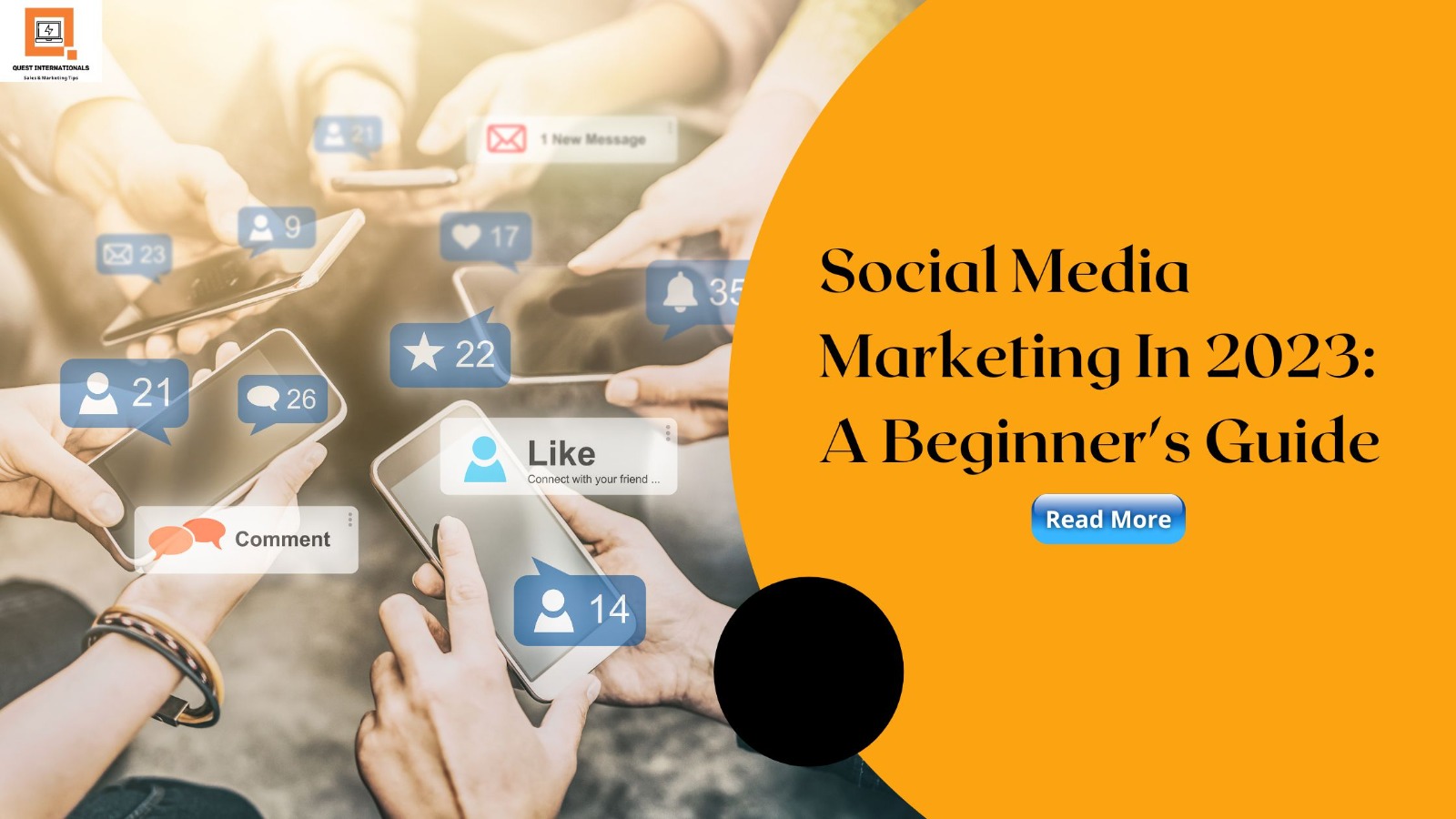Table of Contents
ToggleSocial media marketing(SMM) is the practice of using social media platforms to promote products, services, or ideas to a targeted audience. With the rise of social media, businesses, and as well as individuals can reach a large number of people in a short amount of time, making it an essential component of modern marketing strategies.
It is important because it allows businesses to build relationships with their customers, increase brand awareness, and drive sales. By utilizing social media platforms, businesses can engage with their audience, share their message, and also create a community of loyal followers. This beginner’s guide to SMM in 2023 will provide an overview of the current state of social media, how to set goals, create a plan, and implement a successful strategy. Additionally, we will explore the latest trends in social media and provide insights into how to leverage them for business success.
Understanding Social Media Marketing in 2023
A. The current state of social media platforms:
Social media platforms are constantly evolving, with new features, updates, and changes being introduced regularly. In 2023, social media platforms are expected to continue to dominate the digital landscape, with platforms such as Facebook, Instagram, Twitter, LinkedIn, and TikTok remaining popular among users and marketers.
B. The impact of AI on social media:
Artificial Intelligence (AI) is increasingly being used in SMM to analyze data, improve targeting, and personalize content. In 2023, AI is expected to have an even greater impact on social media, with increased use of chatbots, AI-powered voice assistants, and personalized recommendations for users.
C. Changes in social media user behavior:
In recent years, social media user behavior has shifted, with users becoming more concerned about privacy, authenticity, and transparency. In 2023, users are expected to continue to demand more control over their data, increased transparency from social media platforms, and also more personalized and engaging experiences. This means that businesses will need to adapt their social media strategies to meet these changing user needs. Adapting social media for any business is a difficult task that’s why our team of experts has made a magazine named “Marketing Enigma”, the must-read magazine for all things marketing. Our expert contributors cover everything from social media marketing to SEO, email marketing, branding, and more. Stay up-to-date with the latest industry news, learn from the best in the business, and gain a competitive edge with Marketing Enigma. Subscribe today and also take your marketing skills to the next level!

Setting Goals for social media marketing
A. Identifying the target audience:
Before creating an SMM plan, it is important to identify the target audience. This involves understanding their demographics, interests, behaviors, and preferences. By understanding the target audience, businesses can tailor their social media content and as well as messaging to better resonate with their audience.
B. Defining marketing goals:
Once the target audience has been identified, businesses need to define their SMM goals. These goals could include increasing brand awareness, generating leads, driving sales, or building customer loyalty. It is important to define specific, measurable, attainable, relevant, and time-bound (SMART) goals to ensure that the efforts are focused and effective.
C. Establishing key performance indicators (KPIs):
To measure the success of social media marketing efforts, businesses need to establish key performance indicators (KPIs). These KPIs could include metrics such as reach, engagement, website traffic, lead generation, conversion rates, or return on investment (ROI). By tracking KPIs regularly, businesses can identify what is working and what needs to be adjusted to achieve their marketing goals. Setting goals is one of the best way how to make a social media marketing plan.
Creating a SMM Plan
Not all social media platforms are created equal, and each platform has its own unique audience and features. When creating a social media marketing plan, businesses should choose the platforms that align with their target audience and marketing goals. For example, Instagram is popular among younger demographics, while LinkedIn is more business-focused. It is important to consider factors such as audience demographics, and content format, and engagement levels when choosing social media platforms.
A content strategy is a plan for creating and sharing valuable, relevant, and engaging content on social media platforms. When developing a content strategy, businesses should consider their target audience, marketing goals, and brand voice. They should also identify the types of content that resonate with their audience, such as video, images, or written content. By creating a content calendar and regularly posting high-quality content, businesses can build a loyal social media following.
Paid social media advertising involves paying to promote content or ads on social media platforms. Paid advertising allows businesses to target specific audiences based on demographics, interests, behaviors, and location. It can be a powerful way to reach new customers, increase brand awareness, and drive sales. When utilizing paid social media advertising, businesses should consider their budget, target audience, and marketing goals to ensure that their ads are effective and targeted.
Implementing a Social Media Marketing Strategy
To implement a social media strategy, businesses need to build a strong social media presence. This involves creating and optimizing social media profiles, developing a content strategy, and engaging with followers. By consistently posting high-quality content, businesses can build a loyal social media following and increase their brand awareness.
Engagement is a key component of social media strategy, and businesses should make an effort to engage with their followers regularly. This involves responding to comments, messages, and mentions, and creating opportunities for two-way communication. By engaging with followers, businesses can build relationships, gather feedback, and foster a sense of community. Measuring the success of SMM efforts is essential to ensure that the strategy is effective and aligned with business goals. Businesses should regularly track and analyze metrics such as reach, engagement, website traffic, and conversion rates. Based on these metrics, businesses can adjust their SMM strategy to optimize for success. This could involve adjusting the content strategy, targeting different audiences, or investing in paid advertising. By continually measuring and adjusting the SMM strategy, businesses can achieve greater success and meet their marketing goals.
Leveraging Social Media Trends in 2023
A. Influencer marketing:
Influencer marketing involves partnering with individuals who have a large social media following to promote products or services. In 2023, influencer marketing is expected to continue to be a popular trend in SMM. To leverage influencer marketing, businesses should identify influencers who align with their brand values and target audience. They should also develop a strategy for working with influencers, such as offering product discounts or commission-based partnerships. There are different type of types of social media marketing strategies available.
B. Social commerce:
Social commerce refers to the buying and selling of products directly on social media platforms. In 2023, social commerce is expected to become more prevalent as social media platforms continue to add shopping features. To leverage social commerce, businesses should optimize their social media profiles for selling, offer exclusive discounts or promotions to social media followers, and create engaging product content to attract potential customers.
C. Video marketing:
Video marketing involves creating and sharing video content on social media platforms. To leverage video marketing, businesses should create engaging and informative video content that resonates with their target audience. This could include product demos, behind-the-scenes glimpses, or educational content. They should also consider optimizing video content for specific social media platforms, such as creating vertical videos for Instagram Stories or short-form videos for TikTok.
Conclusion
In 2023, SMM is expected to continue to be a vital component of digital marketing strategies for businesses of all sizes. We hope you have now understood how to make a social media marketing plan after reading the blog. The rise of AI, changes in social media user behavior, and new trends like influencer marketing and social commerce are expected to shape the social media landscape in the coming years. SMM can be a powerful tool for businesses to reach and engage with their target audience.
By setting clear goals, developing a strategy, and leveraging trends like influencer marketing, social commerce, and video marketing, businesses can achieve success in their efforts. However, it is important to continually measure and adjust the strategy to ensure that it is well aligned with business goals and delivering results. We hope you enjoyed reading this blog and don’t forget to subscribe to our ‘Marketing Enigma’ Magazine. Click on the button below now.





